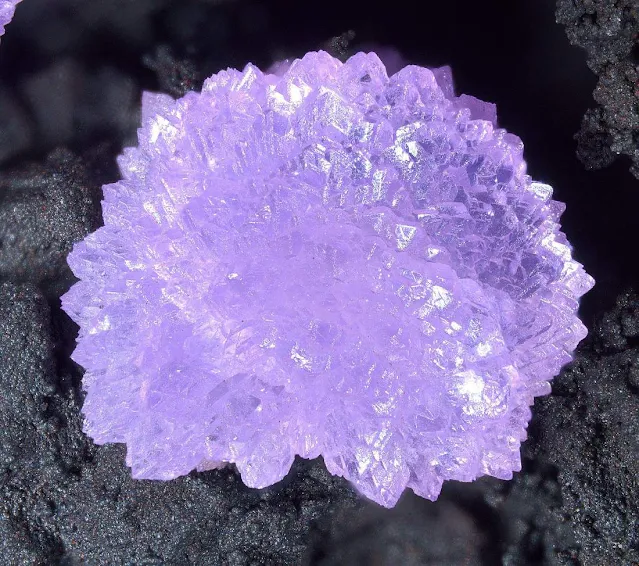Strengite Mineral Information
Strengite
is a relatively rare iron phosphate mineral. Strengite is the end member of a series with Variscite, with Strengite being the iron-dominant member and Variscite being the aluminum-dominant member.
Strengite is isostructrual with the iron arsenate di-hydrate Scorodite. The term ‘isostructural’ means the two mineral shares the same crystal form. Strengite also forms a chemical series with Varicite which is an aluminum phosphate di-hydrate.
Though similar in composition, Strengite and Variscite strongly differ in their color. While Variscite has greenish hues, Strengite is mostly in violet or reddish. The color caused by iron will dominate, and will cause Variscite rich in iron to have a violet or reddish color similar to Strengite.
.jpeg) |
| Strengite Mineral Information Photo Copyright: Dieter Strangfeld |
Strengite forms a series with the more common mineral variscite, AlPO₄·2(H₂O). A series is where different minerals will easily allow certain atoms to freely substitute for each other. In this case iron and aluminum can substitute for each other in variscite and strengite without any disturbance of the crystal structure. Usually the two minerals are fairly pure in nature, but some nearly intermediate specimens have been found.
Strengite is a beautiful mineral and is hard to find on the mineral markets. The best samples are usually small and micromounts are seemingly more available than cabinet samples. Once a specimen is obtained, it will no doubt become a real treasure for the owner.
 |
| Strengite specimen from the Leveäniemi Mine, Svappavaara from North Sweden. Photo: Joy Desor Mineralanalytik |
The mineral is named after the German mineralogist Johann August Streng (1830–1897).
The specimen in the photo is From: Hagendorf South Pegmatite, Hagendorf, Waidhaus, Neustadt an der Waldnaab District, Upper Palatinate, Bavaria, Germany
Properties of Strengite
Composition: Chemical Formula FePO₄ · 2H₂O (Iron(II) phosphate dihydrate)
Color: Primarily purple, violet, pink, peach-blossom red, carmine red, greenish white; colorless to pale pink in transmitted light.
Luster: Vitreous to sub-vitreous, meaning glassy with a slightly waxy or greasy appearance.
Streak: White.
Hardness: 3 1/2 to 4 on the Mohs scale, making it relatively soft and vulnerable to scratches.
Cleavage: Good in one direction (010), poor in another (001). This means it tends to break along specific planes.
Crystal Form: Orthorhombic, usually found in radial fibrous, botryoidal, or spherical aggregates and crusts. Less commonly, it can form prismatic or lath-shaped crystals.
Density: 2.84 - 2.87 g/cm³, relatively heavy for its size due to the presence of iron.
Transparency: Can be transparent, translucent, or opaque. Gem-quality strengite is usually translucent to transparent.
Fracture: Conchoidal, meaning it breaks with smooth, curved surfaces.
Solubility: Insoluble in common acids and water.
Magnetism: Non-magnetic.
Fluorescence: Inert, meaning it does not glow under ultraviolet light.
Pleochroism: Slight pleochroism can be observed, where the color appears slightly different depending on the viewing angle.
Refractive Index: 1.697 - 1.708 (α), 1.708 - 1.719 (β), 1.741 - 1.745 (γ). This refers to the way light bends as it enters the mineral, influencing its brilliance and dispersion.


%20(1).webp)





